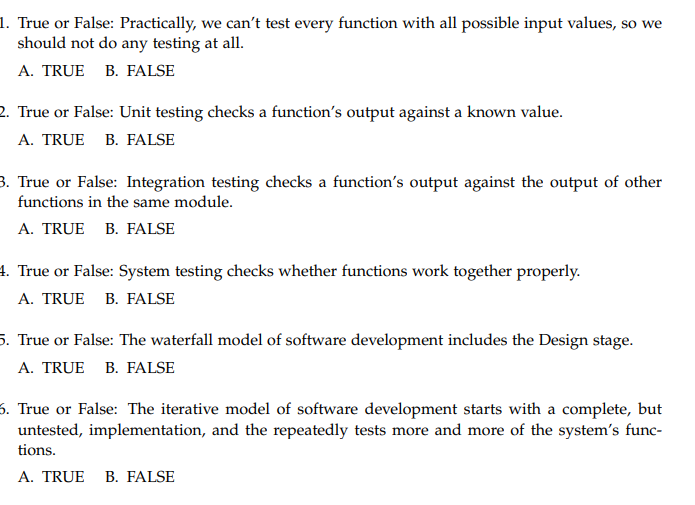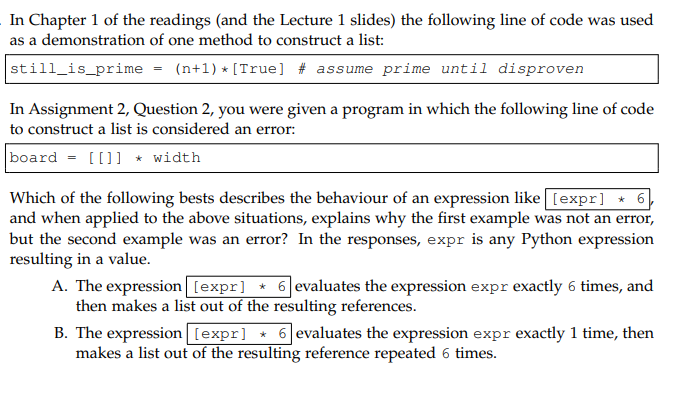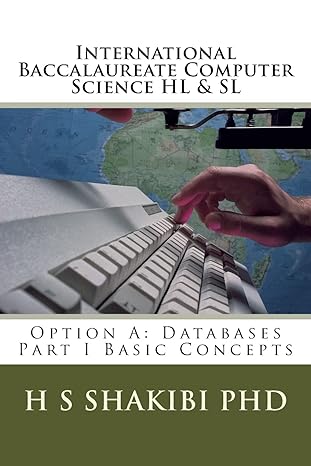

1. True or False: Practically, we can't test every function with all possible input values, so we should not do any testing at all. A. TRUE B. FALSE 2. True or False: Unit testing checks a function's output against a known value. A. TRUE B. FALSE 3. True or False: Integration testing checks a function's output against the output of other functions in the same module. A. TRUE B. FALSE 4. True or False: System testing checks whether functions work together properly. A. TRUE B. FALSE 5. True or False: The waterfall model of software development includes the Design stage. A. TRUE B. FALSE 5. True or False: The iterative model of software development starts with a complete, but untested, implementation, and the repeatedly tests more and more of the system's func- tions. A. TRUE B. FALSE - In Chapter 1 of the readings (and the Lecture 1 slides) the following line of code was used as a demonstration of one method to construct a list: still_is_prime = (n+1) *[True) # assume prime until disproven In Assignment 2, Question 2, you were given a program in which the following line of code to construct a list is considered an error: board = [0]] * width Which of the following bests describes the behaviour of an expression like [expr] * 6 and when applied to the above situations, explains why the first example was not an error, but the second example was an error? In the responses, expr is any Python expression resulting in a value. A. The expression [expr] * 6 evaluates the expression expr exactly 6 times, and then makes a list out of the resulting references. B. The expression (expr] * 6 evaluates the expression expr exactly 1 time, then makes a list out of the resulting reference repeated 6 times. 1. True or False: Practically, we can't test every function with all possible input values, so we should not do any testing at all. A. TRUE B. FALSE 2. True or False: Unit testing checks a function's output against a known value. A. TRUE B. FALSE 3. True or False: Integration testing checks a function's output against the output of other functions in the same module. A. TRUE B. FALSE 4. True or False: System testing checks whether functions work together properly. A. TRUE B. FALSE 5. True or False: The waterfall model of software development includes the Design stage. A. TRUE B. FALSE 5. True or False: The iterative model of software development starts with a complete, but untested, implementation, and the repeatedly tests more and more of the system's func- tions. A. TRUE B. FALSE - In Chapter 1 of the readings (and the Lecture 1 slides) the following line of code was used as a demonstration of one method to construct a list: still_is_prime = (n+1) *[True) # assume prime until disproven In Assignment 2, Question 2, you were given a program in which the following line of code to construct a list is considered an error: board = [0]] * width Which of the following bests describes the behaviour of an expression like [expr] * 6 and when applied to the above situations, explains why the first example was not an error, but the second example was an error? In the responses, expr is any Python expression resulting in a value. A. The expression [expr] * 6 evaluates the expression expr exactly 6 times, and then makes a list out of the resulting references. B. The expression (expr] * 6 evaluates the expression expr exactly 1 time, then makes a list out of the resulting reference repeated 6 times








